DONKEYS
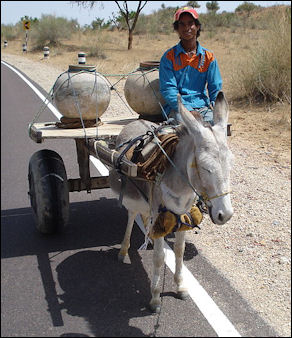
Donkey carrying water
in Thar, India Donkeys, or asses, are horselike animals used to pull plows and carts and to carry loads. Sometimes they are ridden. Their milk and meat is generally not consumed. Donkeys are not nearly as strong as horses or oxen which are used for the same purposes. They are used mostly by poor farmers because are relatively cheap to purchase and maintain and are hardy and require little care.
Donkeys are tough and sturdy. They can travel a long time without drinking, which makes therm particularly prized in arid and semi-raid regions. They generally eat grass and alfalfa. Donkeys are generally docile and plodding. They don’t convey too much emotion. It is hard to tell when one is sick. Donkeys are famous for being stubborn and uncooperative but for the most part they always do what there told, albeit sometimes reluctantly.
Donkeys are usually grey, brown or russet. Most are females. Males are more aggressive and tend to ne castrated. A male donkey is called a jackass. A female is called a jennet. Young are called colts. A group is called a herd or drove.
Mules are sterile crosses between female horses and male donkeys. The donkeys used to breed mules are very large, standing 4½ feet to six feet at the shoulder an weighing around 1,200 pounds. Mules have traditionally been used to pull carts. Mules were first cloned in 2003. They were the first hybrid to cloned.
A burro is a kind of donkey that has been developed over the centuries in Mexico and the southwest United States. Smaller than many Old World donkey varieties, it stands about 50 inches tall at the shoulder and weighs about 500 pounds and has a shaggy coat.
History and Domestication of Donkeys
Donkeys were among the first members of the horse family to be domesticated. They are believed to have been domesticated from wild asses, or onagers, from Arabia and North Africa about 6,000 years ago. See Onagers Below
A bas-relief from the Sumerian city of Ur — dated to 2500 B.C. — shows four onagers (donkeylike animals) pulling a cart for a king. and were supposed to date sometime from 4000 BC. The Sumerians had no camels or horses. They did have sheep, goats and oxen which could be used as beasts of burden. Wheeled vehicles were used as carts. Most were pulled by oxen, onagers or donkeys.
Donkeys and onagers were the main beasts of burden. Goods were moved overland by donkey caravans. Donkeys and onagers later were replaced by horses who are less stubborn, faster, and have a lower threshold of pain (donkey's often do not move even when furiously whipped). The Assyrians and Egyptians used horses and chariots. The Hittites and the Hykos were the first people in the Middle East to use chariots. Chariots came before mounted riders.
Donkeys appeared in Egypt in the third millennium before Christ and are pictured on old Kingdom engravings dated to 2700 B.C., carrying people and loads in villages and urban areas. In the Old Testament the prophet Balaam was saved by a talking ass, who helped the prophet communicate with an angel he couldn’t see. In the New Testament Jesus made his final entry into Jerusalem on one. In Roman times, Nero's wife is said to have bathed in donkey milk scented with rose oil.
Donkeys and People
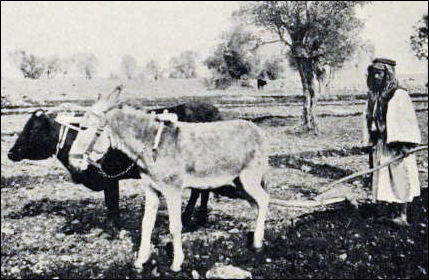
donkey ploughing in Judea Donkeys represent the cheapest and easiest means of transport in rural areas. They are ideal for carrying waste and agricultural crops. They can easily be taken into fields without damaging crops. In some places you can find surprisingly large men riding very small donkeys, which amble along quickly as they are wacked with a stick.
Donkey sell for as little as $20 and as much $350. Often times they sell for more money in poor countries than rich ones because they are much more valued. Large amounts of land are used to grow alfalfa to feed donkeys.
Donkeys traditionally have been looked down on as foolish animals and held in much lower esteem than noble and spirited horses. In the many parts of the Middle East and the developing world to call person a donkey is one of the worst insults you can hurl at someone.
Donkeys are sometimes horribly maltreated. Young boys have cut off their ears and doused them with gasoline and set them on fire. Owners sometimes hobble them with ropes and wires that dig deeply into their flesh. In Israel they have been by shot soldiers worried they might be rigged with explosives.
As societies become more affluent, donkeys are replaced by other animals and machines. In most countries the number of donkeys has declined.
Donkey Milk
In the 2010s there was a renewed interest in donkey milk after Pope Francis reported being fed it as a baby, and scientists have reported encouraging results on the use of donkey milk to treat people with psoriasis, eczema, and asthma.
Donkey milk is the closest known milk to human breast milk in terms of high lactose ratios and low fat content. It is also rich in vitamins, contains anti-bacterial agents, reported to be 200 times more active than in cow’s milk, and anti-allergens, which are believed to be responsible for alleviating psoriasis, eczema, asthma, and bronchitis. According to MailOnline. “Like humans, donkeys have a single stomach. Yet we mostly drink the milk of multi-stomached animals such as cows and goats, which use a lot of bacteria to digest their food through a complicated fermentation process.”
With all these benefits, why isn’t it more readily available. The answer lies in its production. A female donkey produces an average of 0.3 litres of milk a day (maximum 1 litre) for only half of the year, while cows are forced to deliver 30 times as much throughout the year. Furthermore, a donkey “won’t produce milk unless it’s stimulated by the presence of its foal, and milking has to be done manually,” writes the MailOnline. As a result, the milk sells for an extremely high price, €24 (approx. $30) a litre in Cyprus, and in other European countries the price is even double.
Despite this donkey milk remains fairly popular in South America, where it can be readily found at street markets. According to Associated Press donkey milk is sold on the streets of Chile: Ricardo Alegria is a different sort of milk man,” writes AP. “For a quarter century or more, he and his brother Marco have led donkeys through the streets of Chile’s capital, milking them on the spot for customers.” Ricardo Alegria said the milk taken as a “vitamin jolt” for babies with stomach problems, but that adults often drink it too. While many may be put off by the price of this precious milk, a donkey seller from Golden Donkeys Farm in the village of Skarinou, Cyprus, told MailOnline that 60ml a day is “all you need to protect your body”.
Donkey Milk in Ancient Times and the 1800s
In ancient times donkey milk was hailed as an elixir of long life, a cure-all for a variety of ailments, and a powerful tonic capable of rejuvenating the skin. Cleopatra (60 – 39 B.C.) reportedly bathed in donkey milk every day to preserve her beauty and youthful looks. According to legend 700 asses were needed to provide enough milk to meet her needs. It was believed that donkey milk renders the skin more delicate, preserves its whiteness, and erases facial wrinkles. According to ancient historian Pliny the Elder, Poppaea Sabina (30 – 65 AD), the wife of Roman Emperor Nero, was also an advocate of ass milk and would have whole troops of donkeys accompany her on journeys so that she too could bathe in the milk. [Source:worldtruth.tv, February 1, 2015]
The Greek physician Hippocrates (460 – 370 B.C.) was the first to describe the medicinal virtues of donkey milk, and prescribed it as a cure for range of ailments, including nose bleeds, poisoning, liver problems, infectious diseases, fevers, joint pains, and wounds. Roman historian Pliny the Elder (23 – 79 AD) wrote extensively about its health benefits. In his work Naturalis Historia, volume 28, Pliny wrote that fatigue, eye stains, weakened teeth, face wrinkles, ulcerations, asthma and certain gynecological troubles could all be treated with donkey milk. “Asses’ milk, in cases where gypsum, white-lead, sulphur, or quick-silver, have been taken internally. This last is good too for constipation attendant upon fever, and is remarkably useful as a gargle for ulcerations of the throat. It is taken, also, internally, by patients suffering from atrophy, for the purpose of recruiting their exhausted strength; as also in cases of fever unattended with head-ache. The ancients held it as one of their grand secrets, to administer to children, before taking food, a semisextarius of asses’ milk.”
“Over the centuries, donkey’s milk continued to be recognized for its medicinal properties. In the 1800s, donkeys were used at a hospital for assisted children in Paris to aid in the recovery of children with congenital or contagious diseases. Napoleon’s sister, Pauline Bonaparte (1780–1825 AD), was also reported to have used ass milk for her skin’s health care.
The Popular Science Monthly, Volume 22, reported: “The infants were at first fed with goat’s milk, but it was soon found that ass’s milk was better for them; and they are now all fed with milk which they draw directly from the teat of the animal. One, two, and sometimes three children are presented to the ass at the same time, being held at the teat in the arms of the nurse, and the operation is performed with wonderful ease. Numbers speak most eloquently of the success of the method. During six months, eighty-six children afflicted with congenital and contagious diseases were fed at the nursery. The first six were fed, by stress of particular circumstances, with cow’s milk from the bottle; only one of them recovered. Forty-two were nursed at the teat of the goat; eight recovered, thirty-four died. Thirty-eight were nursed at the teat of the ass; twenty-eight recovered, ten died. In the face of such results there can be hardly any hesitation in declaring that in hospitals, at least, the best method of feeding new-born children, who cannot, for any reason, be confided to a nurse, is to put them to suck directly from the teat of an ass.
Onagers
Onagers (Asian wild asses) are two to 2.5 meters in length, with a 30 to 49 centimeters tail. Standing about 120 centimeters at the shoulder and weighing 200 to 300 kilograms, they are mostly buffy, tawny or gray in color and have a white underside, dark mane, back stripe, ear tips and feathered tail tip. They eat a variety of vegetation, including grasses and succulent plants. Females and young form loose, wandering herds while young males form bachelor groups. Senior males occupy a territory and fend of rivals with kicks and bites.
Onagers mostly eat sparse grasses and herbs that grow along desert edges. In the summer when water is scarce onagers survive by drinking salty water. Today onagers are threatened by loss of habitat, poaching and competition from grazing animals. About 800 onagers live in four remote desert areas of Iran.
According to Animal Diversity Web: “Onagers (Equus hemionus onager) are found from Mongolia to Saudi Arabia and as far north as southern Russia and Kazakhstan. Some also inhabit northwestern India and Tibet. They have been reintroduced in Mongolia and Iran. Their habitat is mostly the flat regions of the deserts and surrounding foothills. These barren deserts are a harsh environment and receive very little rainfall each year. Because of the harsh conditions that the desert presents, E. hemionus onager must stay within 20 kilometers of a water source. The maximum lifespan of E. hemionus onager is reported to be approximately 40 years. However, whether this information is based on wild or captive animals is not known. [Source: Jill Grogan and Link E. Olson, University of Alaska Fairbanks, Animal Diversity Web, University of Michigan, animaldiversity.org ~]
“In comparison with other Asiatic wild asses, E. hemionus onager is slightly smaller with a paler coat. Onagers have a pale sandy-red colored coat with a light brown dorsal stripe. The dorsal stripe has two surrounding white strips that blend into the lighter colored hind quarters. In addition to the dorsal stripe, onagers also have a shoulder stripe. The flanks, back and underside of onagers are white. In the winter, the coat grows longer and turns grayer and the white parts become more defined. Males and females differ only slightly outwardly, with males being only slightly larger. Males stand 1.5 meters at the shoulder and are about 2 meters in length, weighing about 250 kilograms.” ~
Widely recognized subspecies of the onager include: 1) Mongolian wild ass (khulan), E. h. hemionus — (China, Kazakhstan, Mongolia, and Siberia); 2) Turkmenian kulan (kulan), E. h. kulan — (Afghanistan, China, Kazakhstan, Kyrgyzstan, Siberia, Tajikistan, Turkmenistan and Uzbekistan); 3) Persian onager (gur), E. h. onager — (Afghanistan, Iran, Iraq, and Pakistan); 4) Indian wild ass (khur), E. h. khur - (India and Pakistan); 5) †Syrian wild ass (hemippe), E. h. hemippus - extinct (Iraq, Israel, Jordan, Saudi Arabia, Syria, and Turkey). [Source: Wikipedia]
Early Carts Carts and Onangers
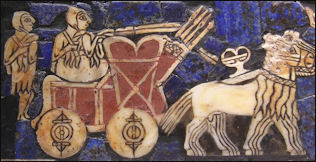
5000-year-old Mesopotamian cart in Ur Animals pulling carts preceded mounted riders by as much as 2,000 years. A bas-relief from the Sumerian city of Ur, dated to 2500 B.C., shows four onanger pulling a cart for a king. The first animals used to pull sledges (carts without wheels) were probably oxen (bulls made more docile by castration). The first carts were probably sledges with logs rolled underneath them.
Over time onangers and donkeys — animals that often will not move even when furiously whipped — were later replaced by horses who are less stubborn, faster, and have a lower threshold for pain than a donkeys. In the second millennia B.C. horses were increasingly to pull weights on the Central Asian steppes. These horses were smaller and shaggier than modern horses, and much more difficult to control than oxen. Deep-furrowed plows also began to be utilized by farmers in the second millennia B.C. Muscular oxen proved to be much better suited for this kind of work than horses.
Herdsman at this time had learned to breed sheep, goats, and cattle, and it follows that they applied what they learned about breeding to horses. Through breeding, horses were made manageable enough to attach to carts with the mouth-fitted bit . By contrast donkeys were controlled by reins attached to nose rings and oxen were harnessed to yokes shaped around their shoulders.
Onager Reproduction
Onager mares breed every other year. According to Animal Diversity Web: “A dominant stallion mates with females in the herd. In order to assure breeding status, stallions defend the territories that females move through, with dominant stallions defending the best territories. During mating season in mid-June, stallions fight each other for mating rights. Females have a short estrus period of 3 to 5 days. After a year-long gestation, mares leave the herd to give birth in a safe place. A single foal is born that stays with its mother for two years. After giving birth, both mare and foal rejoin the herd, where the mother protects her foal from danger. [Source: Jill Grogan and Link E. Olson, University of Alaska Fairbanks, Animal Diversity Web, University of Michigan, animaldiversity.org ~]
“Pregnancy in onagers lasts 365 to 368 days. Nowak reports that lactation in female Equus hemionus (a species of wild ass in which some authorities include onagers) nurse their young for between 1 and 1.5 years. It is reasonable to assume that onagers fall within this range. Young onagers become independent around two years of age. Females are sexually mature around the age of 2, but males, at least in E. hemionus, mature about a year later. ~
“All members of the genus Equus are fairly precocial at birth, and are able to run shortly after birth. During the first two years of a foal's life, it stays with its mother. Mares protect their foals against all dangers. Nursing lasts between 1.5 and 2 years. Although specific details on the relationship between maternal dominance status and status of offsping, it is reasonable to assume that this species is like other members of the genus. If E. hemionus onager is like other horses, maternal dominance status affects status of the young within the herd. The role of males in care of offspring has not been reported. ~
Onager Behavior
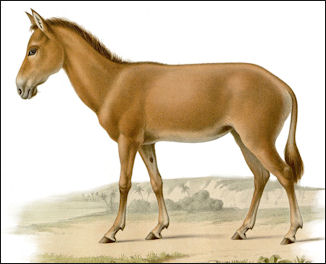
onager
According to Animal Diversity Web: “Equus hemionus onager usually lives in herds, with the exception of older stallions, who can be found living alone. Mares live with their foals in herds made up entirely of other females and young. Data specific to onagers is difficult to find, because of their debated taxonomic status. However, it is reasonable to assume that these animals are similar to E. hemionus, since they are sometimes placed in the same species. With that in mind, the following information on E. hemionus is provided. [Source: Jill Grogan and Link E. Olson, University of Alaska Fairbanks, Animal Diversity Web, University of Michigan, animaldiversity.org ~]
“Herd size may vary. In E. hemionus, average herds contain between 10 and 20 animals, with one male and many females. However, in some ecological conditions, pressure from predators causes small single male groups to come together. Onagers are reported to be crepuscular. However, E. hemionus is reported to be primarily diurnal, feeding during the day and bedding down at night, with some populations feeding at night. ~
“Equus hemionus is able to reach top speeds of about 70 km/hour, and can run at a sustained speed of 50 km/hour. It is likely that onagers are similar in their ability to attain such speeds. Equus hemionus onager has strong senses with an extremely keen sense of smell. Like other members of the genus Equus, onagers have vocal, tactile and chemical communication. In addition, visual signals may be important. ~
“Onagers are reported to have a bad temperment, which makes them unsuitable as work-a-day domestic animals. However, the ancient Roman Legions are thought to have used these animals to pull their war machines. Onagers were previously considered a species, Equus onager, but have since been included as a subspecies of kulans, Equus hemionus. ~
Onager Food Habits and Conservation
Onagers are herbivores that feed on the scarce plant life in the desert. Foods of these animals include grasses, bushes, leaves, roots, tubers, wood, bark, stems, seeds, grains, nuts, herbs and foliage. Onagers receive most of their water from their food, but must remain close to a site of open water. Grazing time for onagers is usually during the cooler part of the day such as morning and evening. [Source: Jill Grogan and Link E. Olson, University of Alaska Fairbanks, Animal Diversity Web, University of Michigan, animaldiversity.org ~]
“Equus hemionus onager has no natural predators other than humans. This species is being driven to extinction due to hunting, competition for food and water with livestock, and loss of natural habitat. Onagers have a well developed sense of smell and can detect potential predators, such as humans, from a far distance. Onagers are also very fast, with the ability to run 60 to 70 kilometers per hour over short distances, and 40 to 50 kilometers per hour for several hours at a time. ~
Onagers are listed as critically endangered on the IUCN Red List. Onagers have been hunted by humans in the past for their flesh and hides. However, in 1971, E. hemionus onager became a protected species in Iran and hunting it is prohibited year-round. Although there is no apparent direct negative economic impact that this species has on humans, it is possible that these wild asses compete with livestock for water and scarce food resources.” ~
World’s Top Donkey Exporting and Importing Countries
World’s Top Exporters (in value terms) of Donkeys (2020): 1) South Africa: US$1744,000; 2) United States: US$868,000; 3) France: US$192,000; 4) United Kingdom: US$136,000; 5) Kyrgyzstan: US$125,000; 6) China: US$76,000; 7) Italy: US$51,000; 8) Niger: US$44,000; 9) Canada: US$16,000; 10) Switzerland: US$13,000; 11) Sweden: US$10,000; 12) Netherlands: US$9,000; 13) Belgium: US$8,000; 14) Germany: US$5,000; 15) Chad: US$5,000; 16) Spain: US$3,000; 17) Norway: US$1,000. [Source: FAOSTAT, Food and Agriculture Organization (U.N.), fao.org]
World’s Top Exporters of Donkeys (2019): 1) South Africa: 145597 head; 2) Niger: 11309 head; 3) Kyrgyzstan: 4620 head; 4) United Kingdom: 1866 head; 5) Netherlands: 1807 head; 6) United States: 1508 head; 7) Kyrgyzstan: 924 tonnes; 8) Netherlands: 655 tonnes; 9) Kazakhstan: 113 head; 10) Belgium: 106 head; 11) United Arab Emirates: 44 head; 12) Colombia: 37 head; 13) France: 25 head; 14) Sweden: 24 head; 15) Kazakhstan: 23 tonnes; 16) Spain: 16 head; 17) Switzerland: 12 head; 18) Brazil: 7 head; 19) Colombia: 7 tonnes; 20) France: 6 tonnes
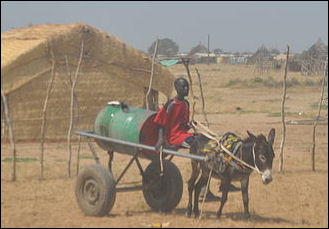
donkey in Sudan World’s Top Importers of Donkeys (2020): 1) United States: 2159 head; 2) Mexico: 2047 head; 3) Belgium: 2008 head; 4) Malaysia: 1240 head; 5) Ireland: 676 head; 6) China: 568 head; 7) Spain: 164 head; 8) Niger: 152 head; 9) China: 114 tonnes; 10) Switzerland: 77 head; 11) Nigeria: 68 head; 12) South Korea: 42 head; 13) Niger: 31 tonnes; 14) Canada: 26 head; 15) New Caledonia: 21 head; 16) Mali: 20 head; 17) France: 20 head; 18) Germany: 19 head; 19) Belgium: 17 tonnes; 20) Switzerland: 15 tonnes [Source: FAOSTAT, Food and Agriculture Organization (U.N.), fao.org]
World’s Top Importers (in value terms) of Donkeys (2020): 1) Mexico: US$476,000; 2) Belgium: US$459,000; 3) China: US$121,000; 4) Switzerland: US$115,000; 5) New Caledonia: US$88,000; 6) South Korea: US$78,000; 7) United States: US$52,000; 8) Norway: US$47,000; 9) Ireland: US$36,000; 10) Spain: US$19,000; 11) Madagascar: US$15,000; 12) Canada: US$14,000; 13) France: US$11,000; 14) Nigeria: US$11,000; 15) Germany: US$10,000; 16) United Kingdom: US$9,000; 17) Mali: US$8,000; 18) Colombia: US$7,000; 19) Luxembourg: US$6,000; 20) Niger: US$6,000; Barbados: US$6,000
World’s Top Donkey Meat Producing Countries
World’s Top Producers of Donkey Meat (2020): 1) China: 97282 tonnes; 2) Niger: 11567 tonnes; 3) Mali: 3617 tonnes; 4) Senegal: 3331 tonnes; 5) Mauritania: 2604 tonnes; 6) Burkina Faso: 1132 tonnes; 7) Argentina: 162 tonnes; 8) Kazakhstan: 4 tonnes. [Source: FAOSTAT, Food and Agriculture Organization (U.N.), fao.org]
Top Donkey-Meat-Producing Countries in 2008 (Production, $1000; Production, metric tons, FAO): 1) China, 127695 , 176000; 2) Niger, 6183 , 8522; 3) Mali, 3878 , 5345; 4) Burkina Faso, 2270 , 3129; 5) Senegal, 1924 , 2652; 6) Mauritania, 933 , 1287; 7) Spain, 170 , 234; 8) Bulgaria, 62 , 85;
World’s Top Producers of Mule Meat (2020): 1) China: 11975 tonnes; 2) Argentina: 112 tonnes. [Source: FAOSTAT, Food and Agriculture Organization (U.N.), fao.org]
World’s Top Mule Exporting and Importing Countries
World’s Top Exporters of Mules (2020): 1) Belgium: 20821 head; 2) United States: 12807 head; 3) Netherlands: 7818 head; 4) United States: 5341 tonnes; 5) Netherlands: 3324 tonnes; 6) Spain: 249 head; 7) Denmark: 226 head; 8) Canada: 105 head; 9) South Africa: 72 head; 10) Belgium: 57 tonnes; 11) Spain: 50 tonnes; 12) Ireland: 46 head; 13) Sweden: 24 head; 14) Denmark: 23 tonnes; 15) Russia: 19 head; 16) Ireland: 12 tonnes; 17) France: 12 head; 18) India: 9 head; 19) United Kingdom: 9 head; 20) Switzerland: 9 head: [Source: FAOSTAT, Food and Agriculture Organization (U.N.), fao.org]
World’s Top Exporters (in value terms) of Mules (2020): 1) United States: US$5020,000; 2) Netherlands: US$770,000; 3) Belgium: US$520,000; 4) Spain: US$372,000; 5) Ireland: US$237,000; 6) United Kingdom: US$127,000; 7) South Africa: US$117,000; 8) France: US$115,000; 9) Denmark: US$109,000; 10) Italy: US$29,000; 11) Sweden: US$27,000; 12) Canada: US$18,000; 13) Luxembourg: US$17,000; 14) Switzerland: US$14,000; 15) Russia: US$13,000; 16) Belarus: US$8,000; 17) Colombia: US$7,000; 18) Hungary: US$4,000; 19) Australia: US$4,000; 20) Germany: US$3,000
World’s Top Importers of Mules (2020): 1) Netherlands: 64880 head; 2) Netherlands: 27588 tonnes; 3) Denmark: 4975 head; 4) Spain: 3699 head; 5) Canada: 2508 head; 6) Italy: 495 head; 7) Mozambique: 300 head; 8) Ireland: 218 head; 9) Italy: 211 tonnes; 10) France: 195 head; 11) Ireland: 152 tonnes; 12) United Kingdom: 144 head; 13) Belgium: 118 head; 14) United States: 105 head; 15) Spain: 103 tonnes; 16) Mexico: 64 head; 17) United Kingdom: 51 tonnes; 18) Tunisia: 47 head; 19) Romania: 38 head; 20) South Africa: 24 head: [Source: FAOSTAT, Food and Agriculture Organization (U.N.), fao.org]
World’s Top Importers (in value terms) of Mules (2020): 1) Netherlands: US$3596,000; 2) Canada: US$3579,000; 3) Ireland: US$1445,000; 4) Greece: US$737,000; 5) Vietnam: US$441,000; 6) United Kingdom: US$315,000; 7) Spain: US$302,000; 8) Romania: US$161,000; 9) France: US$90,000; 10) Egypt: US$86,000; 11) Mexico: US$49,000; 12) Belgium: US$47,000; 13) Denmark: US$37,000; 14) Switzerland: US$23,000; 15) United States: US$18,000; 16) Italy: US$12,000; 17) Pakistan: US$9,000; 18) Guatemala: US$9,000; 19) Estonia: US$8,000; Bahamas: US$8,000; Cyprus: US$8,000. [Source: FAOSTAT, Food and Agriculture Organization (U.N.), fao.org]
Image Sources: Wikimedia Commons
Text Sources: New York Times, Washington Post, Los Angeles Times, Times of London, Lonely Planet Guides, Library of Congress, U.S. government, Compton’s Encyclopedia, The Guardian, National Geographic, Smithsonian magazine, The New Yorker, Time, Newsweek, Reuters, AP, AFP, Wall Street Journal, The Atlantic Monthly, The Economist, Foreign Policy, Wikipedia, BBC, CNN, and various books, websites and other publications.
Last updated April 2022
